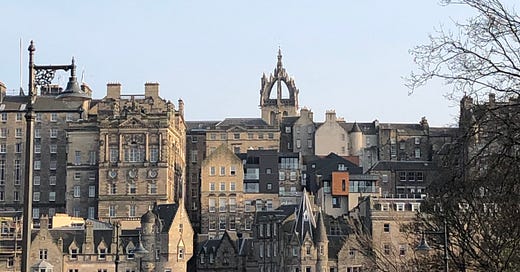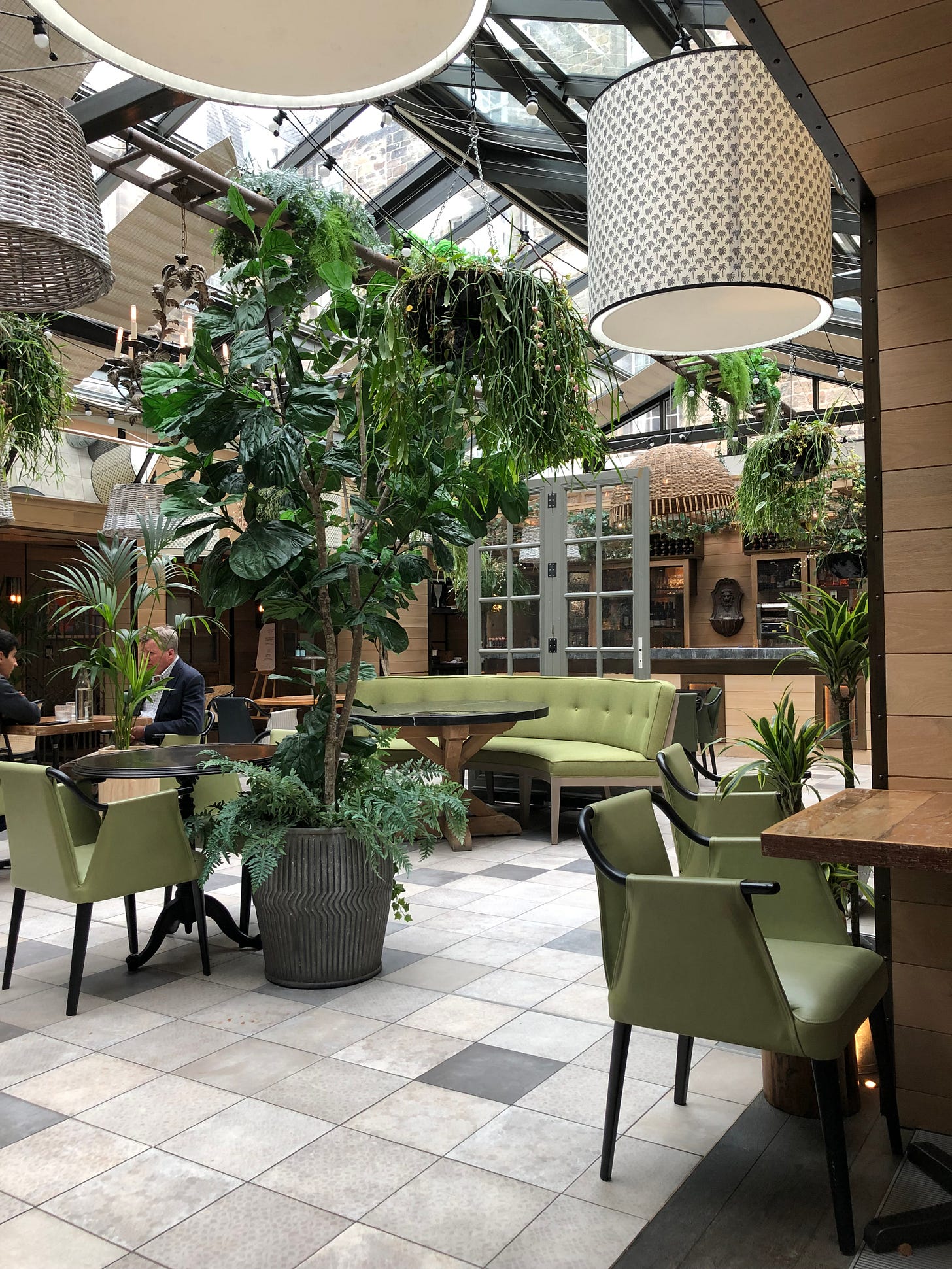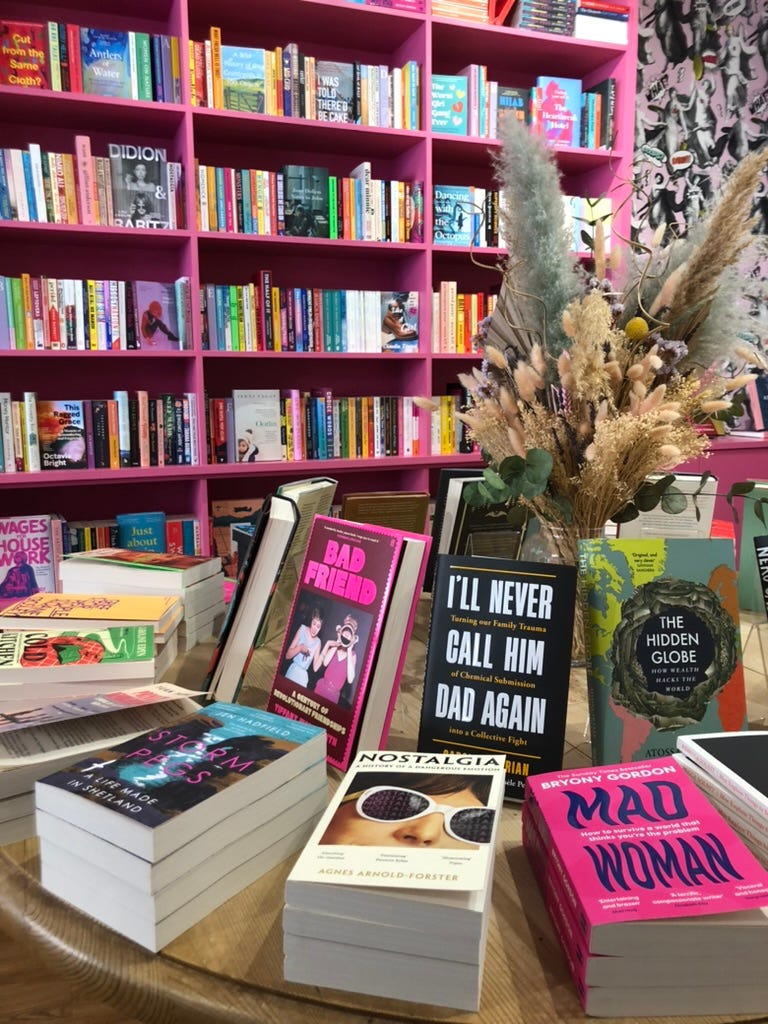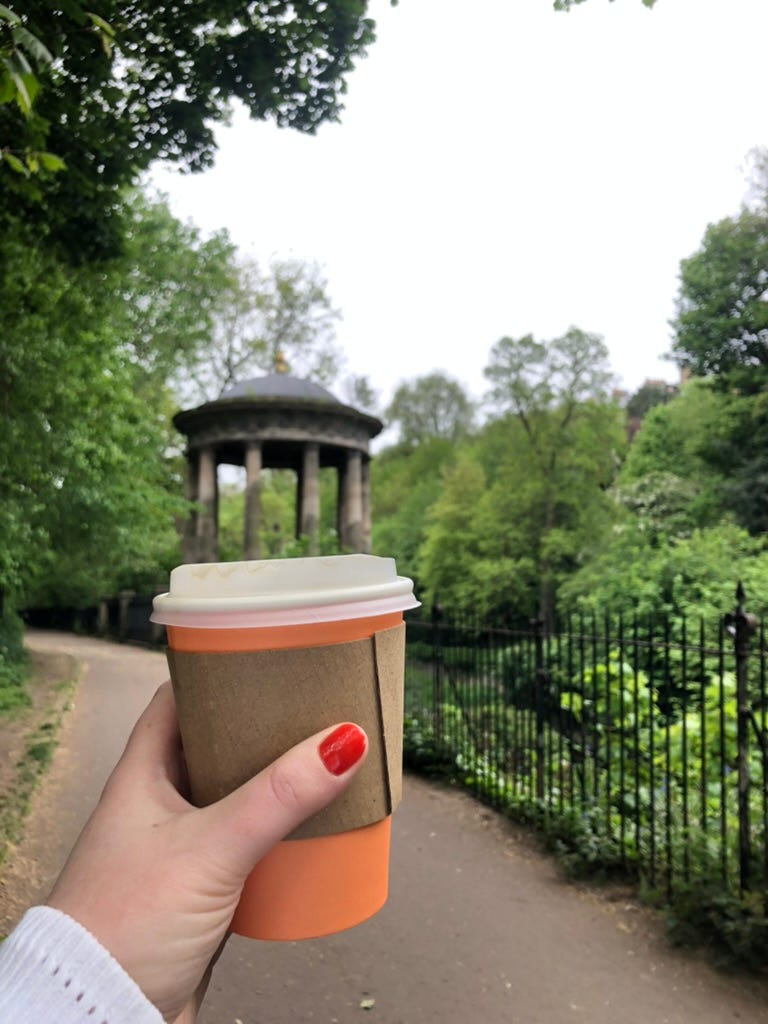A Freelance Writer's Guide to Edinburgh
Where to sip, eat, write, and get inspired in Scotland's capital
Hello writers!
Today we have the first installment of a series that I’m so excited to kick off. Rebecca Low has written a beautiful, comprehensive guide to Edinburgh, with a focus on all the things freelance writers are looking for on the road, like cute coffee shops with wifi, book stores, inspiring walks, and some literary history sprinkled throughout.
If you plan on visiting Edinburgh in the future, keep this one bookmarked. If you don’t have plans to visit Edinburgh, read this and decide to visit, like me. Also, I’m sorry—UNESCO Cities of Literature are a thing?? I’m a little embarrassed that I didn’t know this, and now I want to visit all of them with guides like this one. How cool would it be to do a round-the-world trip built on literary cities and just write our way around the world? And who wants to do this with me??
We’ll have more inspiring city guides coming soon. Enjoy and stayed tuned! And thank you so much to Rebecca for sharing her love and knowledge of writing across Edinburgh with all of us.
Pour yourself a beverage and get cozy for this issue of Wild Writing, which includes:
A Freelance Writer’s Guide to Edinburgh by Rebecca Low
Upcoming deadlines, including a $500 prize for previously published work (you don’t have to write anything new what!), a fellowship for editing an anthology, a dreamy Wyoming residency, and more.
Events and education opportunities for writers
A Freelance Writer's Guide to Edinburgh
By
My favourite view of Edinburgh is looking down from the noisy bustle of Princes Street, over Waverley Bridge, to the higgledy-piggledy skyline of Edinburgh’s medieval Old Town. A puzzling, multi-level mashup of tenements, churches, libraries, civic buildings, hidden courtyards and gardens, the Old Town is bookended by the impressive hulk of Castle Rock in the west and the surprising expanse of Holyrood Park to the east.
The Old Town is traversed by a series of winding closes, or alleyways, with names that range from the mundane to the macabre. In this ancient part of the city, you’ll find Riddle’s Court, Fleshmarket Close, Marlin’s Wynd, the Writer’s Close and even the World’s End. Their names signal a connection to Edinburgh’s majestic and murky past, full of stories of renewal and grave-robbing, poetry and plague. Each close conceals its own secret story about the city's evolution, from a medieval stronghold to a seat of the European Enlightenment. These stories, in turn, have inspired countless more tales throughout Edinburgh’s 900-year history.
Today, Edinburgh’s literary pedigree looms large. It is famous as the home and workplace of a long list of celebrated writers and storytellers, from Robert Louis Stevenson and Muriel Spark, to Maggie O’Farrell and Ian Rankin. Twenty years ago, it became the world’s first UNESCO City of Literature, establishing the blueprint for cities that champion words, writing and ideas. Even the main train station is named after a book.
This writerly heritage is both inspiring and intimidating for scrievers (that’s Scots for writer) of all stripes— including me. I first came to Edinburgh as a wide-eyed student, desperate to escape my small city life for the capital. In my four years at university here, I barely scratched the city’s surface, sticking mainly to campus haunts and the Cowgate’s scuzzy but fun pubs and clubs. I had a great time, but I don’t think I made enough effort to get to know my new home. Outside of essays and one or two pieces for the student paper, I wasn’t doing much writing either.
A few years later, the itch for city living brought me back again, and I’m now coming up on my first full decade as an Edinburgh resident. At first, it took me a while to be able to confidently call myself a writer, not least because living in Edinburgh means you are surrounded by writerly heritage and sparkling celebrity authors. While it’s easy to be dazzled and disoriented by the big names and international crowds that descend on this most literary of cities every year, dig a little deeper and you’ll see there’s plenty to inspire and support writers of all kinds.
Where to Write in Edinburgh
They say that in London, you’re never more than 10 feet away from a rat; in Edinburgh, the same applies to independent coffee shops. Most places are laptop-friendly unless they specifically say otherwise, particularly during the week. Sometimes there’s a designated laptop table, or set ‘laptop days’. Generally, as long as you buy a couple of coffees and/or some food, you can sit for an hour or two without feeling guilty. If you’d like a longer writing stint, I’d suggest decamping to one of Edinburgh’s brilliant public libraries.
When I’m choosing a cafe to write in, there are three things that I look for: good coffee, good wifi and good people. These check all three of boxes and more.
Fortitude Coffee
Hamilton Place, Stockbridge
Fortitude Coffee is in the heart of Stockbridge, one of Edinburgh’s most sought-after neighbourhoods. With its village-like feel, Stockbridge feels a million miles away from the tourist crowds of the Old Town. Be warned, though: on the weekend, those same tourists descend on Stockbridge for its bougie farmer’s market, so it can get busy - but who’s working on a Sunday?
On weekdays, Fortitude in Stockbridge is the place to live out your writer-living-in-Edinburgh dreams (I know I do). Stockbridge is the place to people-watch, so you can fully expect your next character inspiration to walk through the door at Fortitude. Have a chat with the lovely staff, order a delicious batch brew and settle into your Edwardian-tiled surroundings next to the locals. And if you see me, say hello!
Charmed by this Stockbridge spot? Here are some more favourites nearby:
A relative newbie, Books n’Cup does a tasty chai latte and is open until 10 pm. Perfect for writers who get inspired after the sun goes down or are racing to meet a deadline.
If you like your writing spots to be sumptuous, wood-panelled and have a banging cocktail menu, then The Register Club on the fourth floor of the Edinburgh Grand Hotel is for you.
Mayvn
George Street, New Town
Full disclosure: Mayvn isn’t a hidden gem. But if you’re after a city centre spot to write or meet in, two minutes from the lush greenery of Princes Street Gardens and stunning views of Edinburgh Castle, Mayvn is a great choice.
The real draw for writers is its central laptop table, a big marble-esque hunk adorned with dried flowers designated for remote workers. There are plenty of comfortable basket chairs, plugs at every station and table service as standard. Working from Mayvn feels more like being in a co-working space than a cafe, so even if you’re on your own, you’ll quickly feel like part of Edinburgh’s cool remote-working community.
If you can’t make it to Mayvn, here are some other good New Town spots to work from:
The Garden at the Kimpton Charlotte Square
Also in a hotel, The Garden is a hidden summerhouse retreat in the middle of Edinburgh. Bright and airy, it’s open to non-hotel residents on weekdays until 3 pm.
The Green Room Bar and Restaurant
William Street is home to several independent shops and restaurants, including The Green Room. Ideal if you like to work with a glass of something cold and delicious; their wine list is great.
Williams & Johnson
Custom Wharf, Leith
Leith is Edinburgh’s historic port, steeped in maritime history. Its cobbled docks still play host to modern cruise ships and the Royal Yacht Britannia, the late Queen Elizabeth II’s favourite floating holiday home. Leith is also home to great cafes, bars and restaurants to write from.
My favourite is Williams & Johnson, a cafe and roastery in Custom Lane, a waterfront creative hub that hosts regular exhibitions and events. You can either book yourself a space in their minimal Scandi-chic co-working space or sit with your laptop in the buzz of the coffee shop itself. The coffee is always delicious, not to mention their sweet treats; I often make the pilgrimage over just to get my hands on one of their tahini and dark chocolate cookies.
If you need some more Leith recommendations, here are a couple of other welcoming spots to write in:
Argonaut is a brilliant independent bookshop that also welcomes remote workers. Grab a (very reasonably priced) iced latte and tap away in the window while you watch the world go by.
The Leith branch of Artisan Roast is low-key but spacious. Expect friendly staff, veggie food and walls covered in community notices. An ideal place to write and get a feel for what’s happening in the neighbourhood.
Where to Learn
Museums and Galleries
Edinburgh wears its cultural credentials proudly, but there is so much more to this city than tartan-clad bagpipers and souvenir tins of shortbread. Edinburgh is home to many of Scotland’s national collections, and you could easily fill a week or two with visits to its many (free!) art galleries and museums. And while Edinburgh is not representative of the whole of Scotland - another discussion for another guide - it’s as good a place as any to start your Scottish cultural education.
If you’re visiting Edinburgh for the first time, you’ll more than likely make a beeline for the world-famous Royal Mile. This is also where you’ll find The Writer’s Museum, which celebrates the lives of three of Scotland’s most famous writers: Sir Walter Scott, Robert Louis Stevenson and the poet Robert Burns. Outside the museum is Makar’s Court, an evolving literary monument where, under your feet, writerly words of wisdom are inscribed from across the centuries.
Return to the Royal Mile and you’re just metres away from the impressive facade of the National Library of Scotland. Inside you’ll find the library’s own ‘treasures gallery’, a revolving collection of literary artefacts including a First Folio of Shakespeare’s plays, a Gutenberg Bible from the 1400s and a letter from Beethoven about his arrangements for some Scottish songs. The National Library is also a serene space to write in, as is the Scottish Poetry Library, another quiet oasis for reading and working, further down the Royal Mile.
If you’re looking for face-to-face inspiration, head to the National Portrait Gallery to meet everyone from Scottish pop culture icons to pioneers of science and tech, immortalised in paint, collage, sculpture and photography. Climb its green velvet staircases and marvel at the murals in the neo-Gothic Great Hall before you stop for a coffee under the watchful eyes of Alan Cumming, Ncuti Gatwa and Nicola Benedetti.
Bookshops
As you might expect from a City of Literature, Edinburgh boasts a stellar selection of independent bookshops, each with its own personality and carefully curated selection. Check out Lighthouse, Edinburgh’s radical bookshop that champions activist, intersectional writing and writers. Or head to Book Lovers for your romantic fiction fix. For a great selection of women writers, try Rare Birds Books, and if you’re looking for that Belle-in-the-Beast’s-library moment, Topping and Co has all the rolling ladders and floor-to-ceiling shelves you could wish for. You’re guaranteed to come away from Edinburgh with a longer TBR list than when you arrived.
If I had to choose my favourite, it would be The Portobello Bookshop. Not only does ‘Porty Books’ have well-stocked shelves, its knowledgeable and dedicated staff run a year-round programme of brilliant, bookish events, and the shop itself is just a hundred metres or so from the beach front.
Writing Communities and Events
Famous around the world as a ‘festival city’, Edinburgh hosts many annual literary events: the Edinburgh International Book Festival, the Scottish Storytelling Festival, Push The Boat Out poetry festival and CYMERA: Scotland’s Festival of Science Fiction, Fantasy and Horror Writing, to name just a few.
Outside of festival time, there are plenty of exciting and supportive communities for writers to get involved with. There are two in particular that I’m a big fan of. Women Who Write Edinburgh run community events and challenges for women and non-binary writers in the city, offering peer support and career advice, as well as time and space to just get those words down. Edinburgh Sparks is a new open mic night for prose writers to share their short stories, novel extracts, personal essays and works-in-progress to a supportive audience.
Where to Get Inspired
If you’re anything like me, your best ideas come when you’re walking. There’s something about physical action that helps to shift any emotional and intellectual weight. As I move through the city on foot, the half-formed ideas and fuzzy plans that refuse to stick while I’m behind a laptop start to click into place.
Luckily, Edinburgh has many beautiful outdoor spaces to walk in, from sandy beaches to riverside rambles to volcanic landscapes, all within striking distance of the city centre. Here are three places I like to wander through to get inspired.
Portobello
If I’m feeling stuck or down, I know that an hour or two spent by the sea will sort me out, so I take myself to Portobello. Portobello, or Porty as it’s affectionately known, is a former Victorian holiday resort. It’s now an eclectic, artsy hub for young families and those looking for a breather from the busy city.
A short bus ride from the city centre takes you to Portobello Beach, a golden, sandy stretch that looks out onto the North Sea and beyond. Sit on one of the promenade's pistachio-coloured benches and watch the waves roll in, or shelter from the east coast’s changeable weather in one of the beach-front cafes. In the height of summer, Portobello throngs with people, from teens lighting barbecues on the beach to the Scottish National Volleyball team getting their practice in, to many, many happy dogs frolicking in the surf. If you’re feeling brave, you can take an invigorating dip before warming up in a seaside sauna.
The Water of Leith
If I can’t make it to Porty but still want to be near some water, then I head out for a walk along the Water of Leith. My favourite stretch of the 13-mile walk takes in the incredible gardens and collections of the National Galleries Modern One and Two, through the picture-perfect Dean Village and Stockbridge, before taking you through the reclaimed railway lines of the North Edinburgh Path and out to 17th-century merchant houses on The Shore in Leith. Squint and you might think you’ve walked to Nyhavn in Copenhagen…
The signposted path weaves close to the riverbank as you walk under a canopy of trees that form a lush, green tunnel in the summertime. Leave your headphones at home and enjoy the endless chorus of birdsong and the rush of the water beside you. If you’re lucky, you might even spot the elusive Leith Kingfisher or some of the Water’s resident otters, as well as other wildlife.
Holyrood Park and Arthur’s Seat
Few cities can say they have a volcano right in the centre of town. Thankfully for residents and visitors, Edinburgh’s Arthur’s Seat is extinct, but that doesn’t make it any less impressive. This ancient volcano dominates the city’s skyline with the sprawling green of Holyrood Park furling out beneath. In spring, the Seat is transformed by a riot of coconut-scented yellow gorse, and even in winter, plenty of people make the trek to its summit.
The walk I like to do doesn’t take in the rocky scramble to the Seat’s peak, though I have done that a few times. I take my feet through Holyrood Park and up the Queen’s Road, a paved path that winds around the Seat and offers stunning views of the Pentland Hills, Edinburgh’s Old Town and out across the water to Fife. The air is fresher (and colder) up there, and there’s something both calming and inspiring about letting your eyes rest on the expanse of the city below.
‘A complicated, beautiful city.’
When I asked friends and colleagues what their favourite thing about being a writer in Edinburgh was, the same answers kept coming up: the city’s history and heritage, its inspiring spaces, and the special writing communities it nurtures. There were also conversations about competition, over-saturation and the tightrope walk that is the tussle between tourists and residents, wealth and want, that plays out daily in Scotland’s capital.
But I guess that’s why writers choose to be in a city, right? For the contradictions and complications, because it’s interesting. Maybe because we’re gluttons for punishment, but mostly because there is so much to see and be inspired by and get involved with here. I asked Edinburgh’s Makar, the poet Michael Pedersen, about what he loves about being a writer here:
“I'm never not aware of Edinburgh's esteemed literary past, it's a galvaniser and a reminder of the exemplary standard of literary lustre this city has produced – it's world-renowned. The present too is, well, ever present…I'm always bumping into my favourite Edina writers, both at literary events and doing the messages [grocery shopping in Scots!]. It's that type of city.
Of course, the festival flocks to town, bringing the Edinburgh International Book Festival with it, and the city transforms itself in a big, glorious dance...for a while, with opportunities running rife, if you've spent some time learning how it all works. The gothic architecture, the secret closes, the razoring rain, and the palmary places to hide from it (museums and galleries, cafes and pubs), they're here all year round. Edinburgh is a complicated, beautiful city; it keeps you on your toes and our writers have to remember to keep it on its toes too. I cherish it.”
I cherish Edinburgh, too, for all its frustrations and contradictions. We may need to work on our relationship from time to time, but I hope it continues to inspire me and others to write and tell its stories for many more years to come.
Upcoming Deadlines
Keep reading with a 7-day free trial
Subscribe to Wild Writing to keep reading this post and get 7 days of free access to the full post archives.











